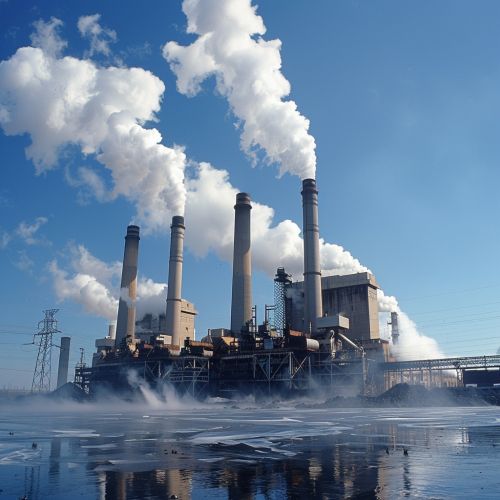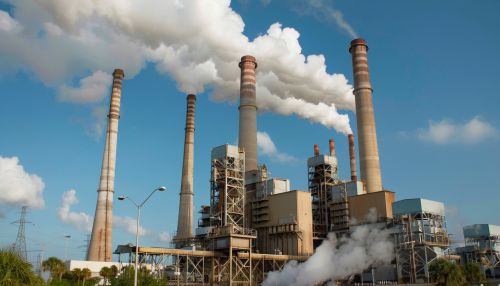Power plant
Overview
A power plant is an industrial facility used to generate electric power. Power plants are essential components of the electrical grid, converting various forms of energy into electrical energy that can be distributed and used by consumers. The most common types of power plants include fossil fuel power plants, nuclear power plants, hydroelectric power plants, and renewable energy power plants such as wind and solar farms.
Types of Power Plants
Fossil Fuel Power Plants
Fossil fuel power plants burn fossil fuels such as coal, natural gas, or oil to produce electricity. These plants are the most common type of power plant worldwide. The process involves burning the fuel to produce heat, which is then used to convert water into steam. The steam drives a steam turbine, which in turn drives an electrical generator.


Coal-Fired Power Plants
Coal-fired power plants are the oldest and most traditional form of fossil fuel power plants. They burn coal to produce heat, which generates steam to drive turbines. Despite their widespread use, coal-fired power plants are criticized for their high emissions of carbon dioxide and other pollutants.
Natural Gas Power Plants
Natural gas power plants use natural gas as their primary fuel. They are more efficient and produce fewer emissions compared to coal-fired power plants. Natural gas plants can be classified into two types: simple cycle gas turbine (SCGT) and combined cycle gas turbine (CCGT) plants. CCGT plants are more efficient as they use both gas and steam turbines to generate electricity.
Oil-Fired Power Plants
Oil-fired power plants are less common due to the high cost of oil and environmental concerns. They operate similarly to coal-fired power plants but use oil as the fuel source.
Nuclear Power Plants
Nuclear power plants generate electricity through nuclear reactions, typically nuclear fission. In a nuclear reactor, the nucleus of an atom splits into smaller parts, releasing a significant amount of energy. This energy is used to produce steam, which drives turbines connected to generators.
Nuclear power plants are known for their high energy output and low greenhouse gas emissions. However, they pose challenges related to nuclear waste disposal and the potential for catastrophic failures, as seen in the Chernobyl disaster and the Fukushima Daiichi nuclear disaster.
Hydroelectric Power Plants
Hydroelectric power plants use the energy of flowing water to generate electricity. These plants typically involve the construction of a dam on a river, creating a reservoir. Water released from the reservoir flows through turbines, generating electricity.
Hydroelectric power is a renewable energy source and produces no direct emissions. However, the construction of dams can have significant environmental and social impacts, including habitat destruction and displacement of communities.
Renewable Energy Power Plants
Renewable energy power plants harness energy from natural sources that are replenished continuously. The most common types include wind farms and solar power plants.
Wind Farms
Wind farms consist of multiple wind turbines that convert the kinetic energy of wind into electrical energy. Wind farms can be located onshore or offshore, with offshore wind farms typically having higher capacity due to stronger and more consistent winds.
Solar Power Plants
Solar power plants use photovoltaic cells or solar thermal systems to convert sunlight into electricity. Photovoltaic cells directly convert sunlight into electrical energy, while solar thermal systems use mirrors or lenses to concentrate sunlight, producing heat that generates steam to drive turbines.
Components of a Power Plant
Boilers and Combustion Chambers
In fossil fuel power plants, boilers and combustion chambers are used to burn fuel and produce heat. The heat converts water into steam, which drives the turbines.
Turbines
Turbines are mechanical devices that convert the energy of steam, water, or wind into mechanical energy. This mechanical energy is then used to drive electrical generators.
Generators
Generators convert mechanical energy from turbines into electrical energy. They operate on the principle of electromagnetic induction, where a conductor moving through a magnetic field induces an electric current.
Cooling Systems
Cooling systems are essential in power plants to dissipate excess heat. In thermal power plants, cooling towers or water bodies are used to cool the steam back into water, which is then reused in the boiler.
Control Systems
Control systems monitor and regulate the operation of power plants. They ensure the efficient and safe operation of the plant by controlling parameters such as temperature, pressure, and flow rates.
Environmental Impact
Power plants, particularly those that burn fossil fuels, have significant environmental impacts. They are major sources of air pollution, emitting pollutants such as sulfur dioxide, nitrogen oxides, and particulate matter. These pollutants can cause respiratory problems and contribute to acid rain.
Power plants are also significant sources of greenhouse gas emissions, particularly carbon dioxide, which contribute to global warming and climate change. Efforts to reduce the environmental impact of power plants include the adoption of cleaner technologies, such as carbon capture and storage (CCS), and the transition to renewable energy sources.
Safety and Regulations
Power plants are subject to stringent safety and environmental regulations to protect workers, the public, and the environment. Regulatory bodies such as the Environmental Protection Agency (EPA) in the United States and the International Atomic Energy Agency (IAEA) for nuclear power plants set standards and guidelines for the operation and maintenance of power plants.
Safety measures in power plants include regular inspections, maintenance, and the implementation of safety protocols. In nuclear power plants, additional safety measures include containment structures, emergency shutdown systems, and radiation monitoring.
Future of Power Plants
The future of power plants is shaped by the need for sustainable and reliable energy sources. The transition to renewable energy is a key trend, driven by the need to reduce greenhouse gas emissions and combat climate change. Advances in technology, such as improvements in energy storage and grid management, are also influencing the development of future power plants.
Emerging technologies, such as fusion power and advanced nuclear reactors, hold the potential to provide abundant and clean energy. However, these technologies are still in the research and development stages and face significant technical and economic challenges.
